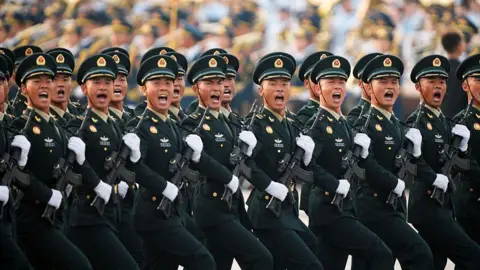Chinese leader Xi Jinping, Russian President Vladimir Putin, and North Korean leader Kim Jong Un stood publicly shoulder to shoulder for the first time on Wednesday, ahead of a massive military parade in central Beijing.
The parade, which marked 80 years since China's victory over Japan in World War Two, saw Beijing unveiling a range of new military hardware – including a new nuclear intercontinental ballistic missile, a new road-bound missile for delivering hypersonic weapons, a new laser weapon, and even 'robotic dog' drones.
This comes at a time when Xi seeks to project Beijing's power on the international stage - not just as the world's second-largest economy, but also as a counterweight to the United States as Trump's tariffs rock the global economic and political order.
Four BBC correspondents assess the significance of Wednesday's parade – what it means, why it matters, and what the spectacle tells us about the 'new world order'.
An enduring image for China - and the world
By Laura Bicker, China correspondent
One of the most enduring images of this military parade took place before the first cannon was fired.
President Xi welcomed North Korea's Kim Jong Un with a long handshake, then moving on to greet Russia's Vladimir Putin before all three walked together to watch the parade, was sheer political theatre.
This was the first time all three leaders have been seen in public together, and they picked their moment well.
But it is this meeting, not just the weapons and troops on show, that appears to have grabbed the attention of Donald Trump.
In response, Trump accused Xi of conspiring against America with the others via Truth Social earlier. The Chinese leader affirmed in his speech that China is on the right side of history.
China filling the vacuum left by US - and what that means for the West
By James Landale, diplomatic correspondent
China's show of military might this week is unsurprising for Western leaders.
President Xi has long aimed to position himself at the centre of a new world order, replacing the failing systems established post-World War Two. This shift sends chills down the spines of Western diplomats as the possibility of a Chinese-led world order emerges.
As harsh U.S. tariffs hasten India's alignment with China, a trend that could reshape global dynamics, the West must grapple with the implications of this new geopolitical landscape.
The weapons that worry the West
By Frank Gardner, security correspondent
The Pentagon and defense officials will be analyzing China's latest military advancements showcased during the parade.
With China's military modernization program, it is catching up, and in some spheres, surpassing the U.S. Hypersonic missiles like the YJ-17 are new threats. Moreover, China's commitment to artificial intelligence in defense systems further underscores the potential transformations in global military dynamics.




















